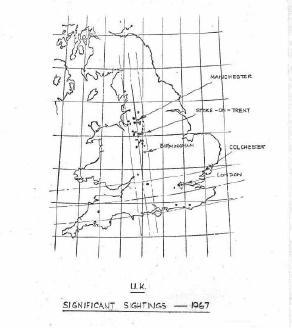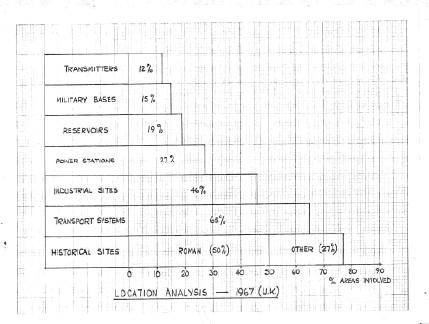UFOs in Reality (4 page)
Authors: T.R. Dutton


Fig. 3
During the design and manufacture of the model, I tried to reproduce all the outstanding features revealed by the Adamski photographs. Falling into this category were the shaped cut-outs in the dark central body beneath the craft, which partially surrounded the three projecting hemispheres. These suggested to me that perhaps the lower centre-body might have been designed to move up and down relative to the bell structure to which the hemispheres were attached. Consideration, next, of the manner in which the cylindrical ‘cabin’ projected from the bell structure, and of the projecting rim surrounding the cabin’s upper edge, further suggested that the cabin might have been able to be retracted into the bell structure in other modes of flight. It seemed to me to be very feasible that the craft had been designed with ‘variable geometry’ features to enable it to adapt to various flight conditions. These revealing details tended to validate the Adamski photographs for me. In my professional pursuits, I had learnt to recognise the possible significance of interesting features revealed by photographs of new aircraft and missiles, for which details had not been released. Unfortunately, many self-appointed sceptics and cynics, undeterred by their ignorance of such things, have always been keen to dismiss the photographs as being clever hoaxes.

Fig 4
In Fig. 4 I have tried to depict the various configurations the craft could have adopted. The first diagram shows how it might have appeared had it actually settled onto the ground. The diagram below it depicts the configuration shown by the photographs, which might have been appropriate for low-speed manoeuvring with a view towards a possible landing. The third diagram demonstrates how the bell structure could have moved upwards to shield the central cabin, perhaps during high speed flight through the atmosphere when, also, the lower centre-body might have been retracted upwards, as shown, to reduce drag or for some other purpose. Since the object was alleged to be a personnel carrier, consideration of the cabin height remaining for any occupants in this fully retracted configuration indicated that it might have been only about 4 feet (1.2 metres). The diagrams at the bottom of Fig.4
show how closely the fully-retracted configuration resembled an early Avco re-entry capsule concept. It seemed just possible, if the supposed occupants of the craft lay prone on couches – mounted on what would later become the cabin’s ceiling – that such a craft could be delivered into the atmosphere, directly, from space, in the manner shown, upsidedown. Presumably, after the craft had entered the lower layers of the atmosphere, the powerplants would have facilitated controlled rotation of the craft into the landing configuration. The occupants could have then un-strapped themselves, legs first, and proceeded to lower themselves, feet first, onto the floor – even as the lower centre-body moved outwards to extend the height of the re-orientated cabin.
The above procedure is feasible, but I have to add that I do not believe it is one generally followed, given the advanced nature of the technology being constantly displayed in our skies. But I have tried to show that there could be much more to those Adamski photographs than anyone else seems to have guessed. Recently, I discussed the photographs with a retired radar expert and asked him – supposing the craft depicted had been real – what the purpose of that lower structure might have been. After careful consideration he made this assessment:-
The central body could have contained microwave emitters, beaming high frequency, pulsed, E-M energy into that parabolic undersurface of the bell structure, which would then have beamed the pulses vertically downwards. From analysis of the differences in the reflection times of the pulses transmitted from different segments of the periphery of the craft, it would then be possible to know whether the ground below the craft was flat enough to land on.
So, there’s another good reason for that strange configuration – one which might explain why, during the alleged encounter in rocky terrain, the Adamski craft did not land but continued to hover. The most likely application for this craft would have been one of descent to, and ascent from, the Earth’s surface. This was no cruising craft. In my view, it would have been the equivalent of that Lunar Excursion Module (LEM), which was designed for the specialised task of taking the Apollo astronauts to and from the Moon’s surface.
References
[1] Pace, A.R. Stanway, R.H. ‘UFOSs, Unidentified, Undeniable’, February, 1968 Newchapel Observatory, Stoke-on-Trent, Staffordshire.
[2] Cramp, L.G. ‘Space, Gravity and the Flying Saucer’ (book)
T. Werner Laurie, Ltd. 1954
Was there any method hidden in the distribution of the sightings of 1967? That was another of the questions addressed in the early days of my research. Fifty impressive sightings were selected for the exercise and the locations of these were plotted on a small-scale map of mainland Britain. The result is shown by Fig. 5.

Fig. 5
A band, only 35 miles (56 km) wide, running magnetic north-south, contained all the events in the North West and Midlands of England. Another band, twice as wide, enveloped the remaining events in the South and South West. This was set at right-angles to the north-south strip. Lines drawn through the centres of the two bands crossed at the site of that very famous prehistoric construction, Stonehenge! Could that be significant? Initially, I recoiled from the idea. It was much too close to Erick von Daneken’s speculations for comfort – so, initially, I dismissed it as being pure coincidence.
However, that simple exercise showed me how apparently organised the activity had been.
So – what was so special about those sites that might have been of interest to someone with an eagle’s eye-view of Britain? That was the next poser to be answered.
Switching my attention to large-scale Ordinance Survey maps of the affected areas, the search began for large man-made features of the landscape which might be of interest to someone visiting this planet from afar. Round each sighting location, a circle of 1 mile (1.6 km) radius was drawn and the features within that circle were noted. Reservoirs, power stations, military areas, airfields, railway stations and sidings, major roads, large residential areas, industrial sites and so on, were initially considered. Then, as an afterthought – after remembering the Stonehenge intersection – I decided to include marked ancient sites. The outcome of the exercise is shown by Fig.6.
Much to my amazement, ancient landmarks came out with top marks, especially those roads built during the period of Roman occupation. 77 % of the selected 1967 event sites had been within 1 mile of known ancient sites. The next features to be favoured had been those associated with transportation, with the newly opened M6 motorway figuring very prominently. In fact, it was discovered that the north-south distribution band followed the path of the M6 from Preston in the North-West down to Stafford in the Midlands. That was as far as the construction had gone in 1967. All along that 70 miles (113 km) stretch of motorway, major new flyover junctions were being constructed to link it with the adjacent towns and cities. And both the Manchester and the Stoke-on-Trent areas were in a state of dramatic transformation as a result of that and other major activities.

Fig. 6
In Manchester and adjacent Salford, vast areas of small terraced housing were being swept away and the residents were being re-housed in tower blocks. Those stark skyscrapers were sprouting like petrified trees out of the desolation of the rubble deserts where, once, people had lived. It was a shock to behold at ground-level, but it would have been a fascinating scene from space.
It was realised that the sites study had not been a truly statistical exercise because the relative abundance of each feature had not been determined at outset. Nevertheless, the results seemed to have some significance – especially so, since the inclusion of ancient sites had been an afterthought. The outcome would have been quite different if they had not been included. After studying the details of the exercise again, it seemed to me to be possible that the probes had been programmed to explore and record all new developments in the vicinity of ancient landmarks, because new roads, motorway flyovers, housing estates and schools often featured in the 1967 sample. This thinking prompted the speculation that perhaps
human development had been monitored throughout the centuries since the original landmarks were created
– a suspicion which seems to have been validated in various ways since then. (Other authors have made similar assertions since the late 1960s, so it seems important to set my speculation in correct historical context – ie. it pre-empted those later writings.)
The 1968 findings on ancient sites were not widely known until I presented them at the 2nd BUFORA National Research Conference in 1976. At first I had regarded them as being too speculative, but during my continued monitoring of British UFO reports from 1967 to 1973, the association of such events with known ancient sites became commonplace. During an eighteen months period between mid 1971 and December 1972, responding to a request from BUFORA, I took on the role of Area Investigator of reported UFO events in N.W England. Resulting from this, the Autumn period of 1972 saw me travelling to and from the Lower Broughton area of Salford
,
Greater Manchester, from my location in North Cheshire. Salford has a long history and, very quickly, it became apparent to me that the events being reported from there were occurring in places of historical interest. In fact, my investigations revealed that the associated visible relics of the Industrial Revolution and the period of Victorian expansionism overlay sites of ancient settlements. Here is an example:-
